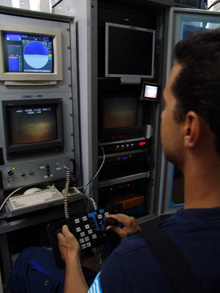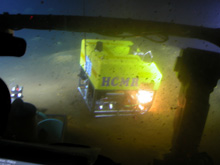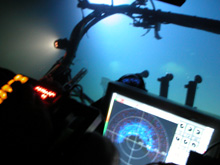
Back on the ship, chief remotely operated vehicle (ROV) pilot Aggelos Mallios maneuvers the ROV Super Achilles over unusual sediment mounds observed during the beginning of the dive. Super Achilles sent live video of the site to scientists stationed on board the research vessel Aegaeo to communicate dive plans and sampling strategy in real-time to the human-occupied vehicle (HOV) Thetis. Click image for larger view and image credit.
Joint Operations
July 1, 2006
36 N, 25 E
Dr. Richard Camilli
Co-Principal Investigator — Project PHAEDRA 2006
Assistant Scientist
Woods Hole Oceanographic Institution
Today I will complete my third dive mission in human-occupied vehicle (HOV) Thetis at our deepest site yet — a location at 350 m (1,150 ft) depth at the island of Santorini. Santorini is a large geologically active volcano classified as a caldera (volcanic depression). Our dive mission is to search for other hydrothermal seeps like those observed at Milos. Today we will descend into the bottom of the volcano to determine if an area within the crater is venting hydrothermal fluids. Investigating this site is important for our understanding of the volcano’s activity. Unlike Milos, which is built from multiple smaller volcanoes, Santorini is one gigantic volcano.
About 3,500 yrs ago, during the time of the ancient Egyptians, the Santorini volcano exploded in a massive eruption. (It is thought to have been one of the largest eruptions within the past one-million yrs). Like Pompeii, the Minoan city of Akrotiri was buried under a thick layer of ash that resulted from this eruption. However, unlike Pompeii, human remains were not found, suggesting that the inhabitants may have left the island before the eruption. Some people believe that Santorini is the mythical island of Atlantis, mentioned by the ancient writer Plato. Not much is known about the ancient history of Santorini. The inhabitants of Akrotiri disappeared without a trace. Many historical and scientific mysteries still surround this island.
It is another beautiful sunny morning as we are lowered into the water. Sunlight cannot penetrate seawater more than about 100 m, and the deeper waters remain in perpetual darkness throughout the world’s oceans. By the time we reach a depth of 200 m, our day turns into night. We switch on Thetis’ external lights as the submersible plunges into total darkness. At 250 m we are surrounded by strange-looking iridescent organisms that live only in these deeper waters. We touch down beside a rocky outcropping at 350 m depth.
Our survey begins by first examining the area suspected to be hydrothermally active. The Gemini mass spectrometer data immediately suggests this hypothesis is incorrect. The water conditions at this site are the same as surrounding water and lack any of the telltale signs of hydrothermal activity that we detected at Milos (i.e., increased concentrations of carbon dioxide, hydrogen sulfide, and methane). Knowing this while still on the dive allows us to immediately communicate our discovery with our Greek scientist colleagues (including biologist Aleka Gogou and geologists Dimitris Sakellariou and Christos Anagnostou) on board the research vessel Aegaeo. Over the next few minutes we make a detailed second examination of the chemical data and quickly discuss the scientific implications, via the “underwater telephone.” Based on our latest clues and combined expertise in biology, geology, and chemistry, we develop a new hypothesis and immediately revise our dive plan. The Hellenic Center for Marine Research (HCMR) Super Achilles robot is on its way down and will soon join us.

After reaching the sea floor and reading signs and sensors indicating no hydrothermal activity is present, Rich Camilli and Kostas Katsaros "call" scientists on the surface to revise the dive plan. Midway through the dive, the Thetis submersible is joined by the Hellenic Center for Marine Research's ROV Super Achilles to conduct a survey of the site. Click image for larger view and image credit.
We gather water and sediment samples from small and unusual, 0.5 m diameter mounds that we encounter on the sea floor. The mounds are made of a yellow-orange material loosely collected above the gray mud and lava-rock bottom. They are easily disturbed by the sub’s propellers, so we have to be very gentle while we collect our samples. The mound’s material reminds me of the little bits of herbs that settle to the bottom in a container of vinaigrette salad dressing.
On one of the mounds we encounter a small fish with unusual whisker-like appendages that protrude from either side of its gills. We watch for a few moments as it swims across one of the mounds while using its “whiskers” to feel its way along the surface of the mound. It appears to be hunting for some lunch, perhaps using these specialized feelers instead of its eyes in this dark environment. Our lights soon attract the attention of several squid lurking just out of sight. Occasionally they rocket into view and send out a jet of ink, resembling shooting stars. Other small squid approach the lights and wrap their tentacles around them, temporarily muffling the lights and casting large magnified shadows on the sea floor.
Midway through our dive mission we are joined by Super Achilles — an ROV that our colleagues at HCMR also use to explore deep-sea environments. Back on the ship, chief ROV pilot Aggelos Mallios is at the controls, deftly maneuvering Super Achilles into position above the mounds. Together we complete our survey of these unusual mounds. Once we complete our sampling tasks and survey of the area the Super Achilles swims back to the surface. After confirmation that Super Achilles has been safely recovered and is back on deck, we receive permission to begin our half-hour long ascent to the surface. This dive mission and recovery proceeds so smoothly that it almost feels like another day’s work in our underwater office and the usual quiet commute back home, carpooling with Kostas.
It now seems likely that the sediment and mounds we encountered on the sea floor are a result of iron being consumed by microbes. Like the microbes at Milos, these microorganisms are probably chemosynthetic, in that they do not rely on photosynthesis to generate their metabolic energy. Unlike the ecosystem at Milos, the microorganisms that we found in the Santorini caldera probably get their energy from oxidizing, or “rusting” iron. Confirmation of this requires further analysis, but it was terrific to see the mission plan evolve in real-time based on the in-situ mass spectrometer data and to be able to conduct joint submersible-ROV operations.
Sign up for the Ocean Explorer E-mail Update List.


















